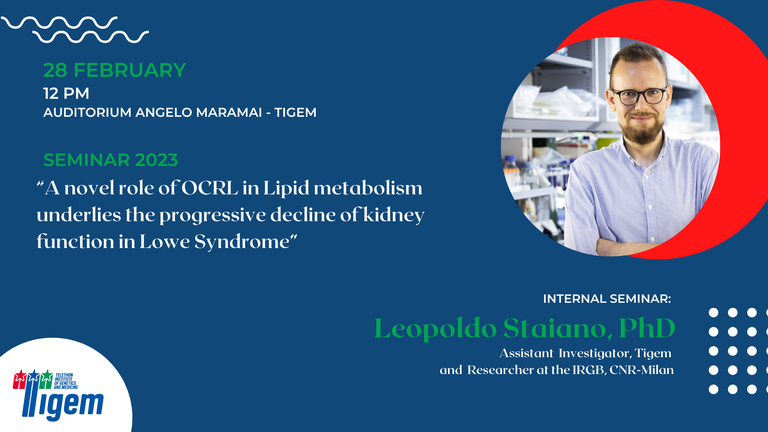Leopoldo Staiano, PhD - "A novel role of OCRL in Lipid metabolism underlies the progressive decline of kidney function in Lowe Syndrome"
- When Feb 28, 2023 from 12:00 PM to 01:15 PM (Europe/Berlin / UTC100)
- Where Tigem Auditorium Angelo Maramai
- Contact Name Leopoldo Staiano
- Contact Phone 08119230659
-
Add event to calendar
iCal

- https://www.tigem.it/leopoldo-staiano-phd-a-novel-role-of-ocrl-in-lipid-metabolism-underlies-the-progressive-decline-of-kidney-function-in-lowe-syndrome
- Leopoldo Staiano, PhD - "A novel role of OCRL in Lipid metabolism underlies the progressive decline of kidney function in Lowe Syndrome"
- 2023-02-28T12:00:00+01:00
- 2023-02-28T13:15:00+01:00
Leopoldo Staiano, PhD (Short CV)
Assistant Investigator, Tigem
and Researcher at the IRGB, CNR-Milan
Abstract
Fatty Acids (FAs) are transported from Lipid Droplets (LDs) to peroxisomes and mitochondria where they are used as a source of energy. Kidney proximal tubule epithelial cells mostly rely on FAs metabolism for energy production and its impairment results in severe cell damage and cell death. Phosphatidylinositol 4,5 bisphosphate (PI4,5P2) favors the contacts between LDs and peroxisomes allowing FAs metabolism and transport to mitochondria. PI4,5P2 level is increased in Lowe Syndrome (LS), a rare genetic disease caused by mutations in OCRL, a PI4,5P2 5-phosphatase characterized by congenital cataracts, intellectual disabilities, and Renal Fanconi Syndrome. The decline of kidney function towards chronic kidney disease (CKD) has been observed in several LS patients, although its pathogenesis is understudied. To discover new molecular mechanisms of proximal tubule dysfunction and CKD in LS we investigated the role of OCRL and PI4,5P2 in the regulation of LDs-peroxisomes-mitochondria interplay and its effect on FAs metabolism. In kidney proximal tubule cells depleted of OCRL, PI4,5P2 accumulates on LDs and peroxisomes reducing the transport of fueling lipids to mitochondria that display lower mitochondrial membrane potential, increased ROS and structural abnormalities. Cells and kidney organoids lacking OCRL display an increased number of PI4,5P2-rich LDs because of the combined impairment of LDs contact with peroxisomes. Finally, kidney organoids lacking OCRL display increased deposition of extracellular matrix and thus increased fibrosis, which is a hallmark of CKD. In summary, this study is paving the way to a wider understanding of kidney dysfunction in LS and aims at the discovery of new fundamental cell biology mechanisms controlled by PI4,5P2 and OCRL.
Assistant Investigator, Tigem
and Researcher at the IRGB, CNR-Milan
Abstract
Fatty Acids (FAs) are transported from Lipid Droplets (LDs) to peroxisomes and mitochondria where they are used as a source of energy. Kidney proximal tubule epithelial cells mostly rely on FAs metabolism for energy production and its impairment results in severe cell damage and cell death. Phosphatidylinositol 4,5 bisphosphate (PI4,5P2) favors the contacts between LDs and peroxisomes allowing FAs metabolism and transport to mitochondria. PI4,5P2 level is increased in Lowe Syndrome (LS), a rare genetic disease caused by mutations in OCRL, a PI4,5P2 5-phosphatase characterized by congenital cataracts, intellectual disabilities, and Renal Fanconi Syndrome. The decline of kidney function towards chronic kidney disease (CKD) has been observed in several LS patients, although its pathogenesis is understudied. To discover new molecular mechanisms of proximal tubule dysfunction and CKD in LS we investigated the role of OCRL and PI4,5P2 in the regulation of LDs-peroxisomes-mitochondria interplay and its effect on FAs metabolism. In kidney proximal tubule cells depleted of OCRL, PI4,5P2 accumulates on LDs and peroxisomes reducing the transport of fueling lipids to mitochondria that display lower mitochondrial membrane potential, increased ROS and structural abnormalities. Cells and kidney organoids lacking OCRL display an increased number of PI4,5P2-rich LDs because of the combined impairment of LDs contact with peroxisomes. Finally, kidney organoids lacking OCRL display increased deposition of extracellular matrix and thus increased fibrosis, which is a hallmark of CKD. In summary, this study is paving the way to a wider understanding of kidney dysfunction in LS and aims at the discovery of new fundamental cell biology mechanisms controlled by PI4,5P2 and OCRL.
